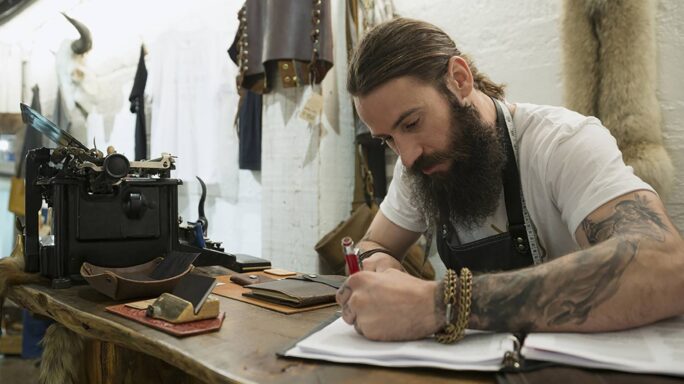Growth & Customers
How to start a craft business
If you’re thinking of starting a craft business, ait’s essential to plan out your journey. Discover how to start a craft business.

Mastering your craft requires plenty of talent, dedication and practice.
But if you’re thinking of turning your creative skills into a full time job or side hustle, you’ll need to get to grips with a whole other skill set: how to for run a company.
In 2021, we created a quiz to test small business readiness in the UK, and more than 1,200 budding entrepreneurs took part (so far). According to the data, just under a third of people (31%) who want to start an arts business currently lack the skills to do so.
In this article, we’ll look at how you can brush up on those business skills and go from an occasional hobbyist to a successful artisan business owner.
Here’s what we cover:
Starting a craft business online
Research demand for your craft product
Create a business plan for your craft business
Decide on your business structure
Administration for a craft business
Develop your craft business’s marketing plan
Are you ready to start a craft business?
Starting a craft business online
Allow yourself to daydream and picture your business 12 months from now: you’re running an e-commerce craft shop with many loyal customers.
You have thousands of followers on your social media channels, and you’re selling your products on a variety of websites and high street boutiques.
It’s an impressive achievement. But how did you get there?
Starting a craft business is achievable for anyone with creative skills, whether they want to run a side hustle or start up full time.
It can be serious business too.
Statistics from the Creative Industries Council show that the 11,620 craft businesses in the UK contribute some £3.4bn to the economy.
It’s also easier than ever to start a craft business today, thanks to the growth of websites that let you sell to customers anywhere in the world.
Keep reading on to find out how to start a creative business.
Research demand for your craft product
You could produce the most beautiful designs in the world, but if there aren’t enough people to buy the product, your business won’t go anywhere.
So, before investing time and energy into your ideas, you should first conduct some market research.
Here’s how to do just that:
- Visit online marketplaces: Head to websites such as Etsy, Not On The High Street or Amazon Homemade and browse for products similar to yours. It’s a good sign if there are several companies working in your category, but it does not yet feel saturated. The aim here is to get a feel for the market – you don’t need to spend days browsing these sites. Rather, you want to find out what’s out there so you have an idea of how to differentiate yourself.
- Check out craft shops and fairs: Visit local craft shops and fairs in your area to see what they’re stocking. Do they already have products like yours for sale? You might even find you can strike up a conversation with the owner to find out if they think your products would sell.
- Do a survey: Try using an online survey tool to gauge interest in your products. If you were selling handbound notebooks, you could ask people how often they buy notebooks, what they use them for, where they buy them and what kind of budget they have. Share your survey on social media and see what response you get.
Create a business plan for your craft business
A business plan is a simple document that summarises what your business is. It doesn’t have to be complicated or full of charts and graphs.
Instead, it’s like a mission statement for why your craft business is awesome, and how it’s going to work.
It should cover:
- What products you will sell
- Who you expect to buy your products
- Where you’ll sell goods (in shops, your own website, online marketplaces, at craft fairs)
- Any other services you’ll offer (such as made-to-measure or teaching)
- Your financial goals
- Pricing for your product.
How they did it: Listen to our Sound Advice podcast (or read the transcript) for our interview with Autumn Rabbitts, founder of creative cake-making studio Plumb and Rabbitts.
Decide on your business structure
Deciding on your company’s structure is an important consideration when you are starting a craft business. The structure you choose will affect your tax bill, how you pay yourself and the amount of admin you need to do.
If you have decided you want to commit to turning your skills into a business, you’ll need to choose a structure before you can begin trading:
- Sole trader: This is the easiest business model to set up. You just need to register with HMRC and you can begin trading. As a sole trader you are personally responsible for all the business’s debts and losses.
- Partnership: If you are running your business with a friend or relative, it might be worth starting a partnership. This structure is similar to a sole trader, but all partners share responsibility for any losses.
- Limited company: This structure means you are only liable for the amount that you invest in the company. If the business were to fail, you wouldn’t personally go bankrupt. Limited company owners might find they pay less tax too.
Crafters who’ve been there before
“Starting a business can be a bit like taking a walk and up ahead there’s a corner – you won’t find out what’s round that corner unless you are prepared to keep walking” – Alastair Bell of Belfast artisanal food business Irish Black Butter.
Administration for a craft business
All business owners need to set aside time each week for administration. It typically includes things like:
- Setting aside tax from any sales
- Calculating your profits and loss
- Monitoring your inventory
- Storing records of all your receipts and expenses.
Read more: How to manage finances for your creative side business
Choosing markets to sell into
Where will you sell your craft product?
Deciding on markets to sell into is an important decision and should be based on thorough research:
Online marketplaces
There are many online craft marketplaces around today. The best known is, of course, Etsy, which has some 60 million buyers every year.
It’s worth remembering that there are many other sites that sell specific kinds of products or that target certain niches. Whether it’s Folksy, Crafty Fox Market or Crafters Market, try browsing other sites to see if they’re right for you.
Building your own e-commerce website
Depending on how many products you plan to sell, it might be worth setting up your own e-commerce website using a website builder such as Shopify.
Having your own website allows you to retain all your profits by selling direct to the customer.
Attending craft fairs
There are thousands of craft fairs taking place across the UK every year.
Although these numbers declined quite drastically throughout 2020 and much of 2021, due to the pandemic, they are starting to return.
You can often find craft fairs listed on Facebook or you can use a website such as Eventbrite to find events in your local area.
Selling direct to craft shops
High-street craft shops are often a great place to sell your products. Visit the store owner to find out if they’d be interested in selling your goods.
Crafters who’ve been there before
“When you’re thinking about starting a new business, use your skills and your passion” – Kate Findlay, of Coventry’s online boutique gift shop Peach Perfect.
Develop your craft business’s marketing plan
Next on your checklist for starting a craft business is to figure out your marketing plan. This will help you to get your designs out there and generate interest.
1. Use social media
Almost all craft businesses today use social media.
These platforms have clever algorithms that promote your content to audiences who would likely be interested in your goods. Each social media platform requires a different sort of marketing strategy and has its own audience.
Unless you’ve got enough time to produce content for them all, it might be better to focus your attention on just one or two:
- Instagram: You will need to create attractive photos of your products that will stand out on people’s feeds.
- TikTok: This is a great place to post interesting videos showing how you create your products.
- Facebook: A mixture of written text, photographs and video content will work well here, particularly if you are considering using paid advertising to reach a wider audience or target a specific demographic.
Each platform has slightly different audience types in terms of age range, and their reasons for using the platform. Take some time to research which platforms your ideal customer spends time on.
2. Build a website
If you’re starting a creative business, you will need a website.
There are many helpful website building tools such as Wix or SquareSpace, which allow you to quickly and easily create a presence online.
As mentioned above, building a strong social media presence will help drive traffic to your website.
You should also create high-quality content to sustain traffic from search engines such as Google or consider using pay-per-click (PPC) advertising to drive prospective customers to key product pages.
3. Invest in branding
As a crafter, you’ve probably got a pretty good eye for design. But it’s worth taking some time to brand your business.
Think about a consistent colour theme, photography and writing style.
Choose a name that is memorable but which also tells people what kind of product you sell.
Crafters who’ve been there before
“Starting out, I felt the pressure to learn marketing, PR, business development, financing for my business and this seemed totally daunting… I wish I knew would be to take advantage of freely available resources and classes to help me quickly develop these invaluable skills” – Lucy Arnold of Manchester-based leggings company Lucy Locket Loves.
4. Don’t scrimp on photography
It is vital you have high-quality photography that puts your products in the best light, especially if you’re starting a craft business online.
The good news is that you don’t necessarily need expensive equipment to begin with. Today’s mobile phones take excellent photos.
That said, if you’re selling higher-value goods, using a professional photographer can be a worthwhile investment.
5. Plan for Christmas and other seasonal peaks
If you’re starting a craft business, it’s important to think about seasonal events where demand is highest so you can prepare your stock and marketing activities.
Christmas is, of course, the most popular season for buying craft gifts. But other periods will also be important, such as Easter, Valentine’s Day, Mother’s Day, Father’s Day and other holidays.
Crafters who’ve been there before
“A few months go by and then you look back and realise how far you’ve come” – Paul Lenihan of Leeds gift card company OPEN Gift Card.
Are you ready to start a craft business?
Your passion for your craft will carry you a long way, but it’s just as important to nurture business skills that will turn your dream into a reality.
Try our business readiness quiz today to see how prepared you are for starting a craft business and get personalised tips on what to do next.
Bootstrap and build your e-commerce side hustle from your spare room
Want to launch your own e-commerce business while juggling a job but not sure where to start? Check out this guide for plenty of tips, covering product sourcing, setting up your website and dealing with HMRC, and more.








Ask the author a question or share your advice